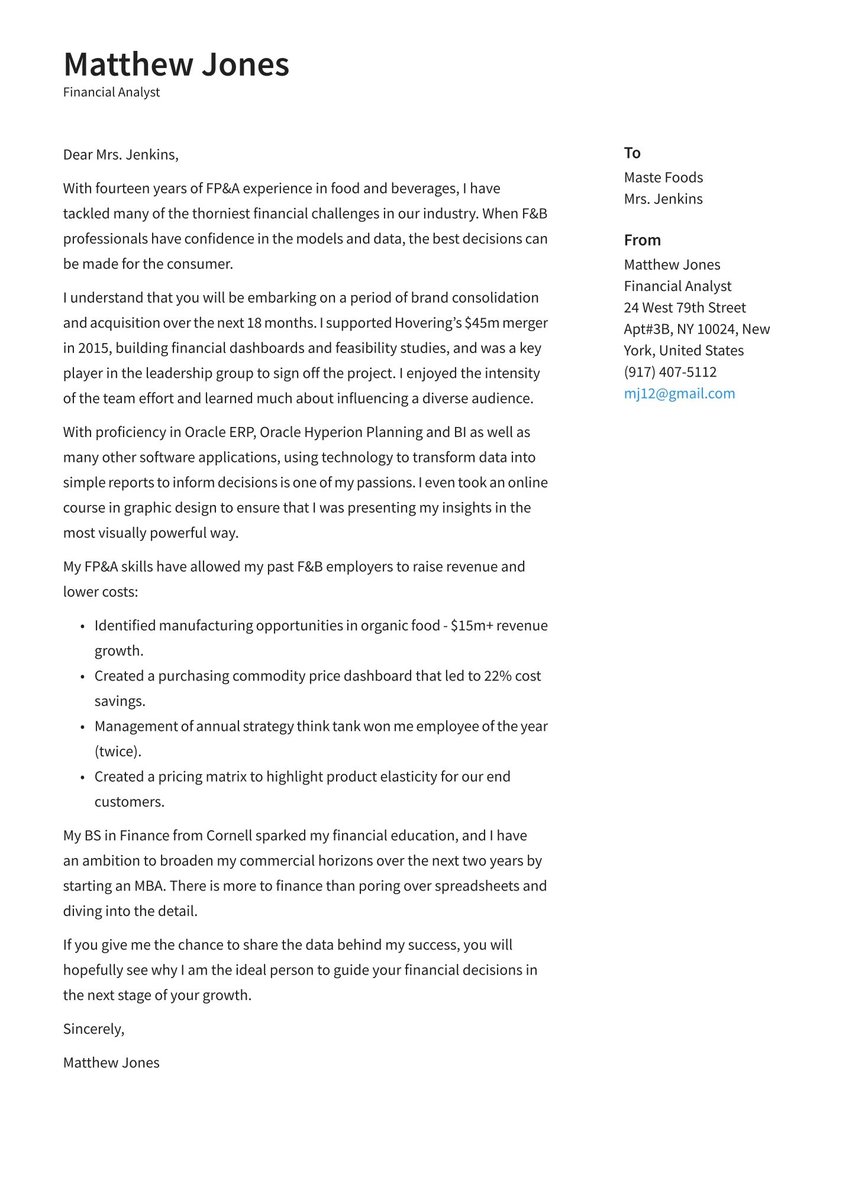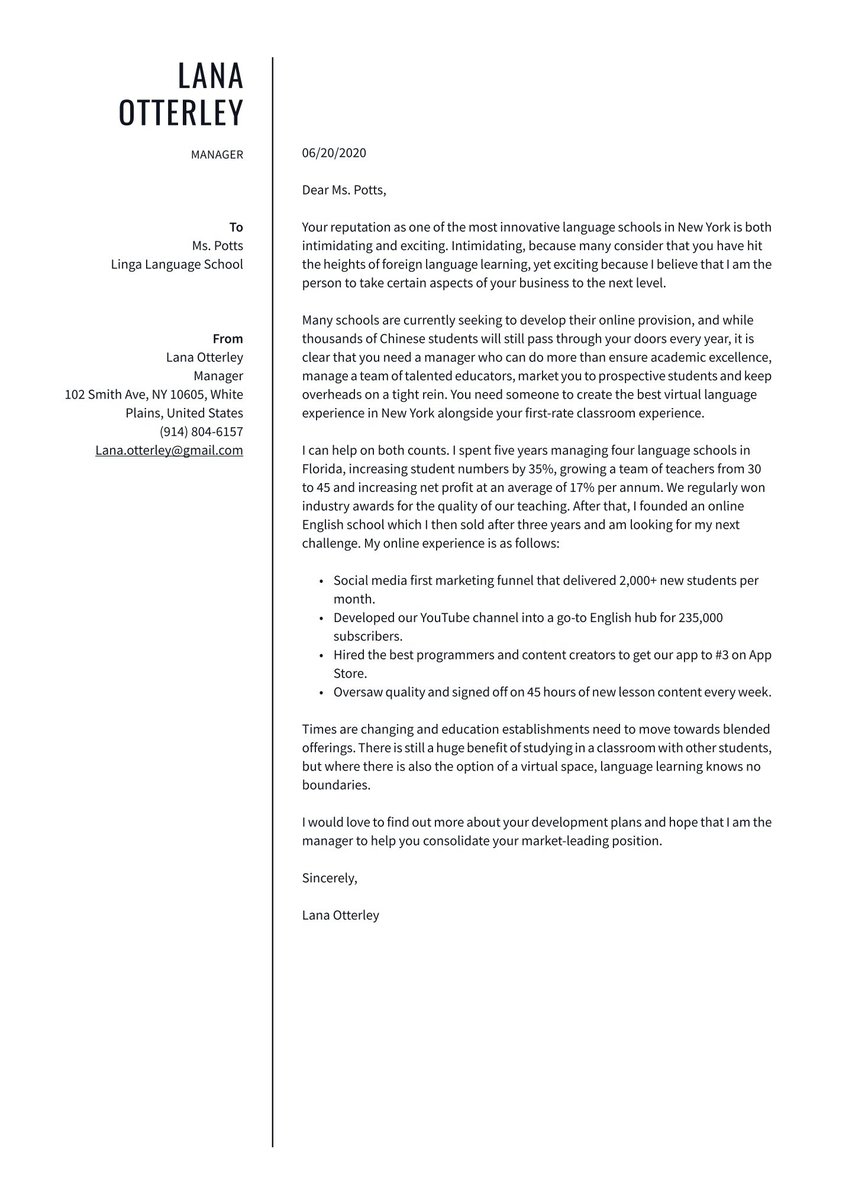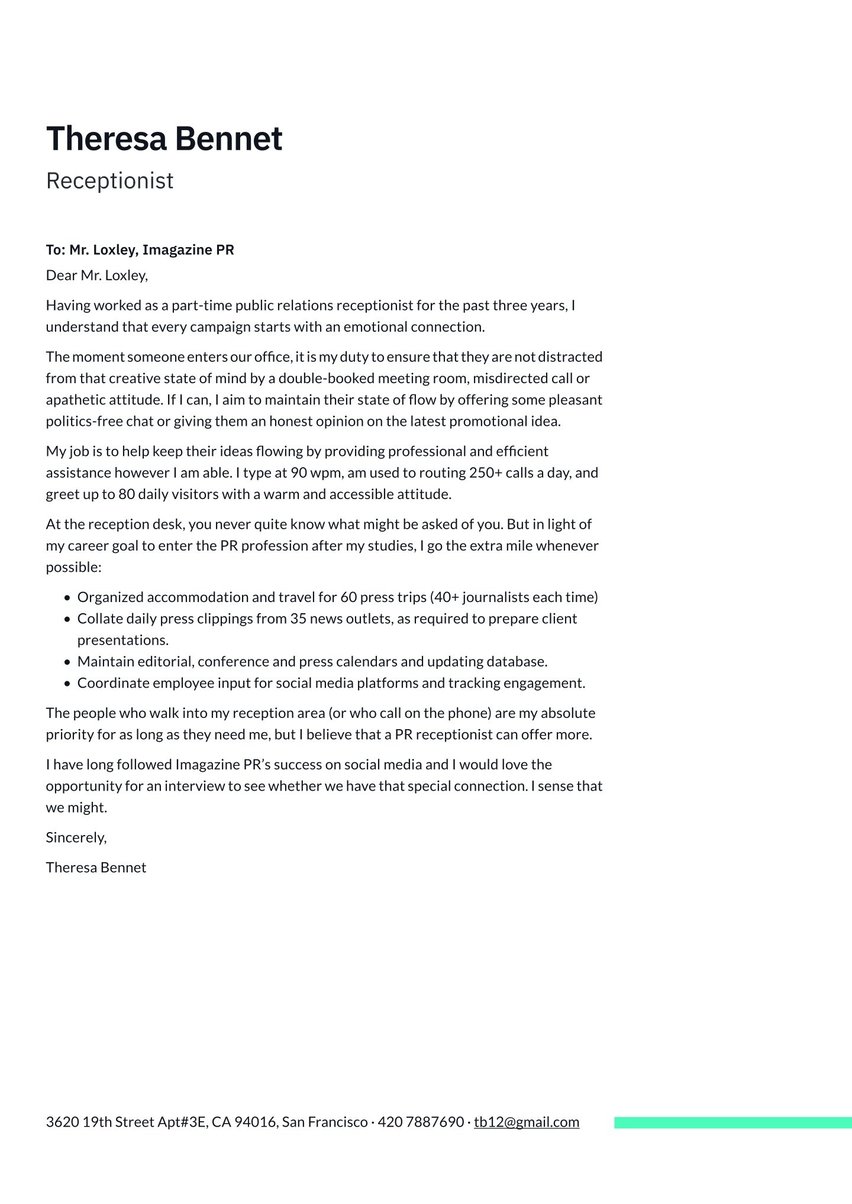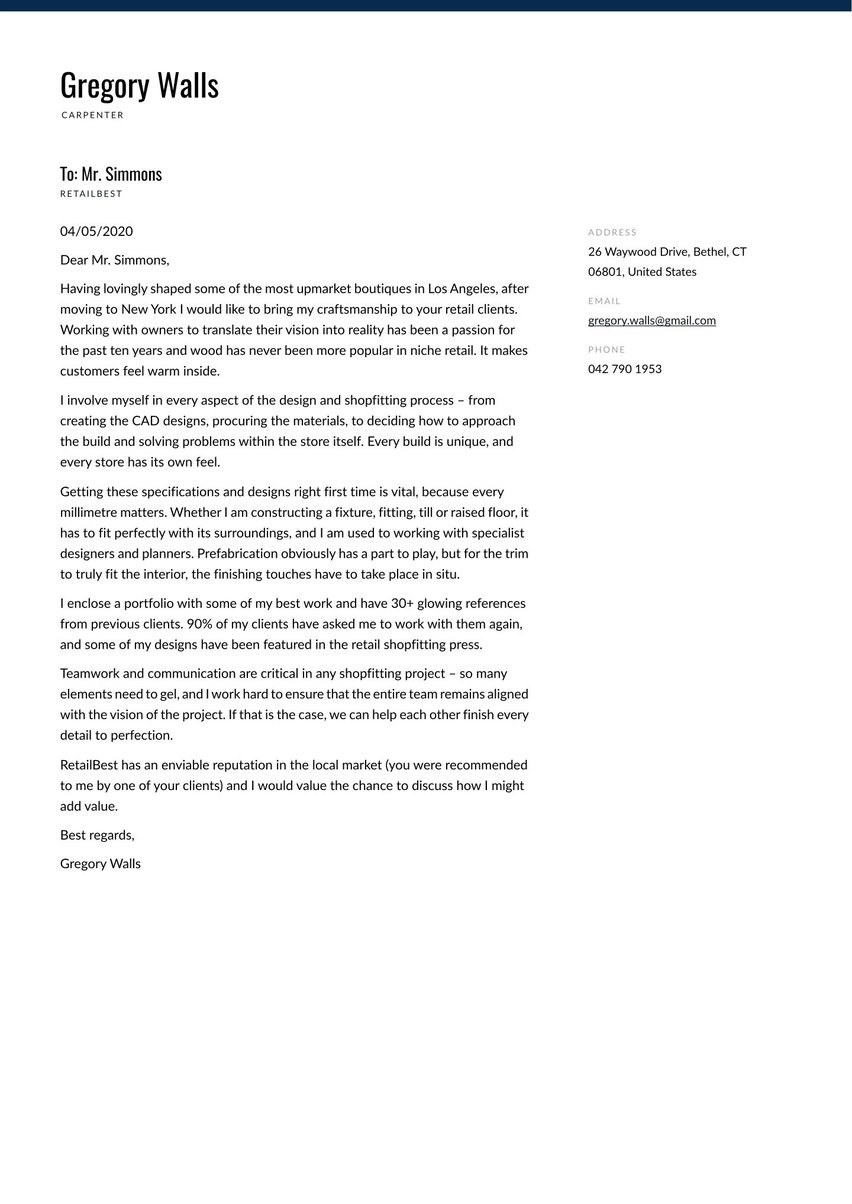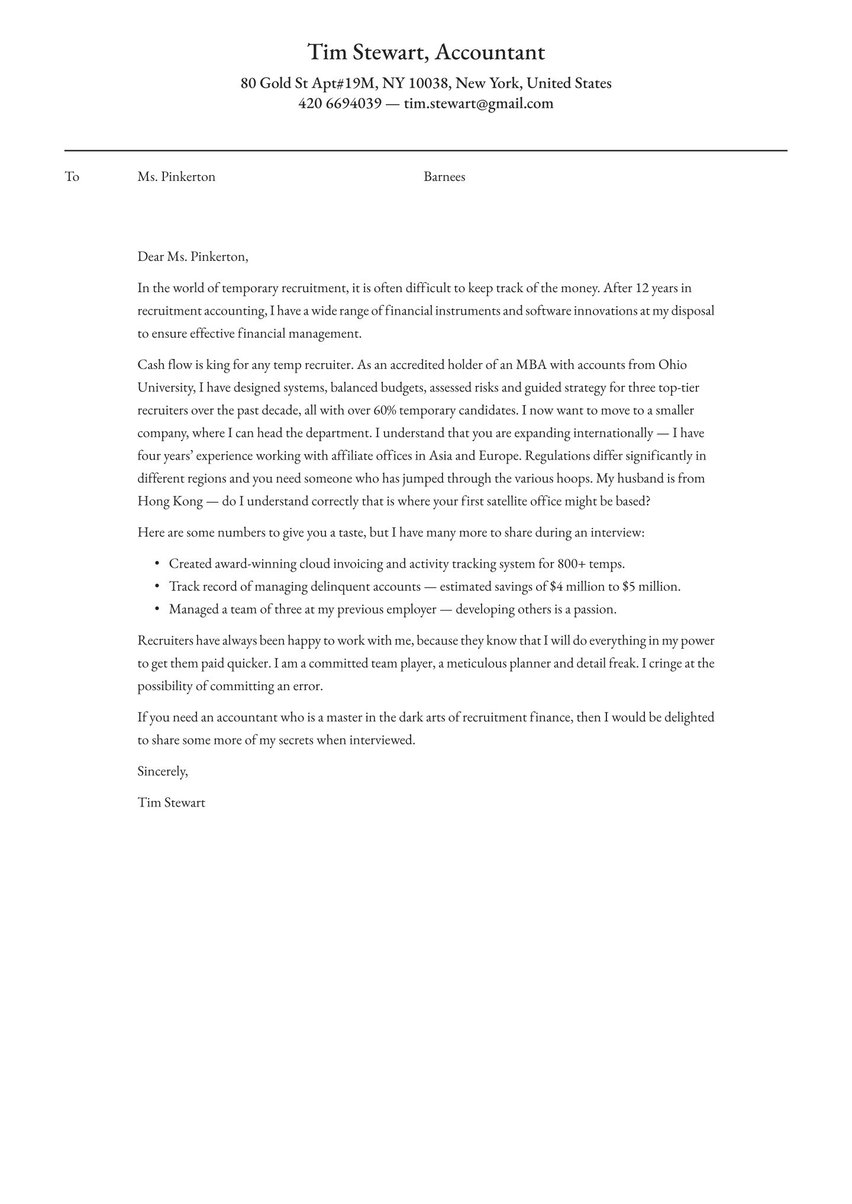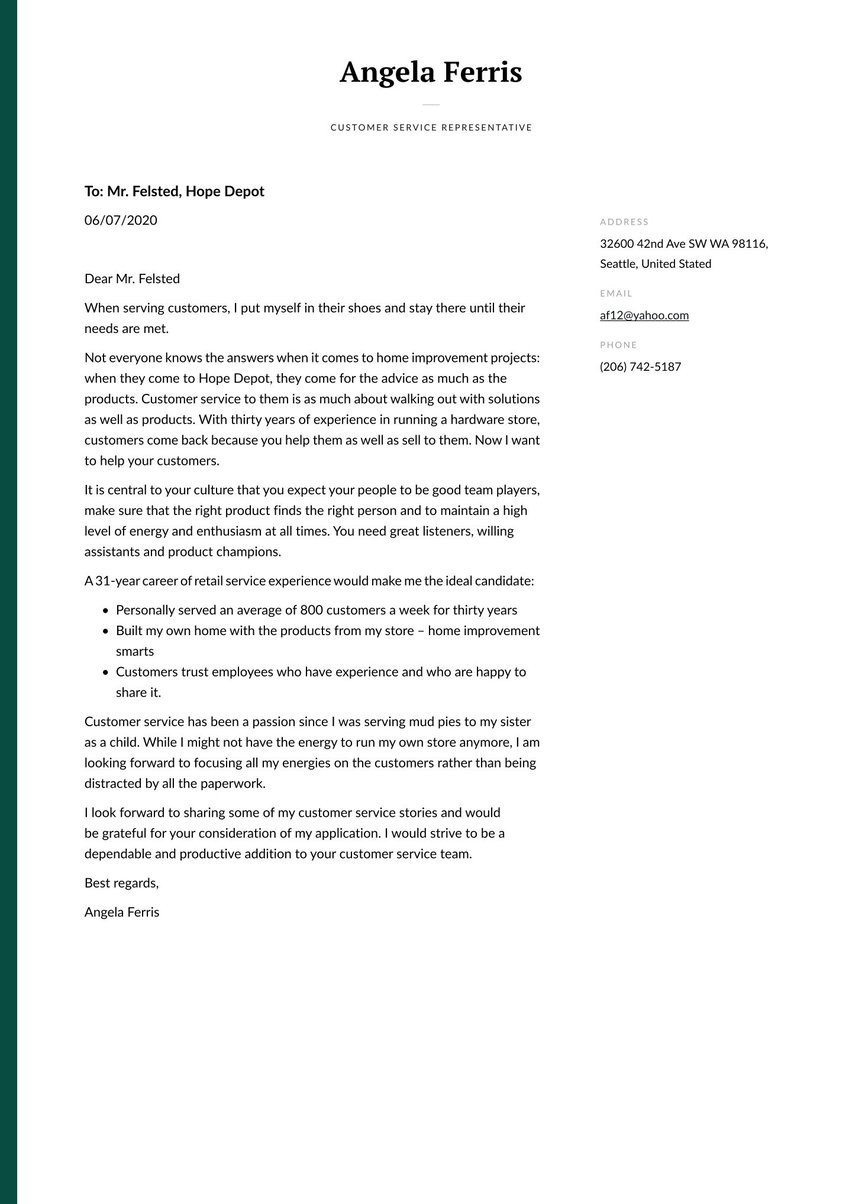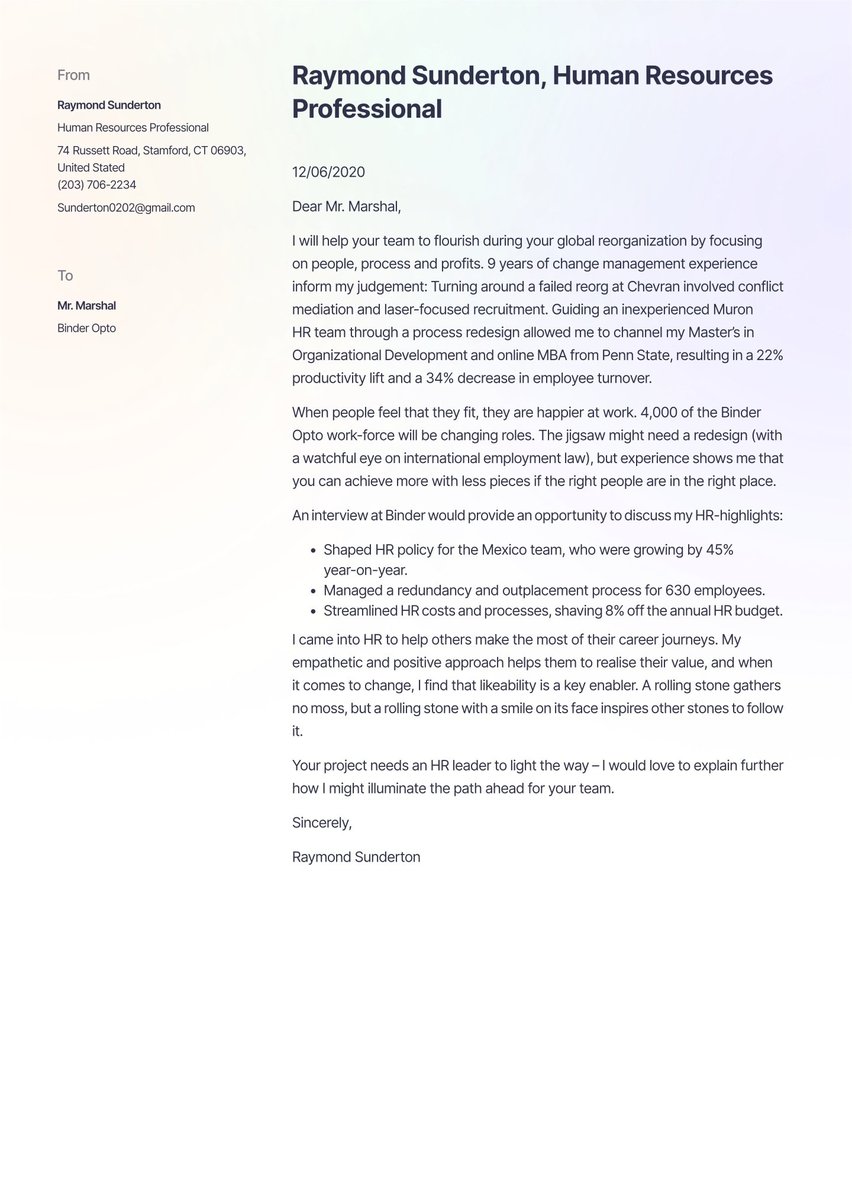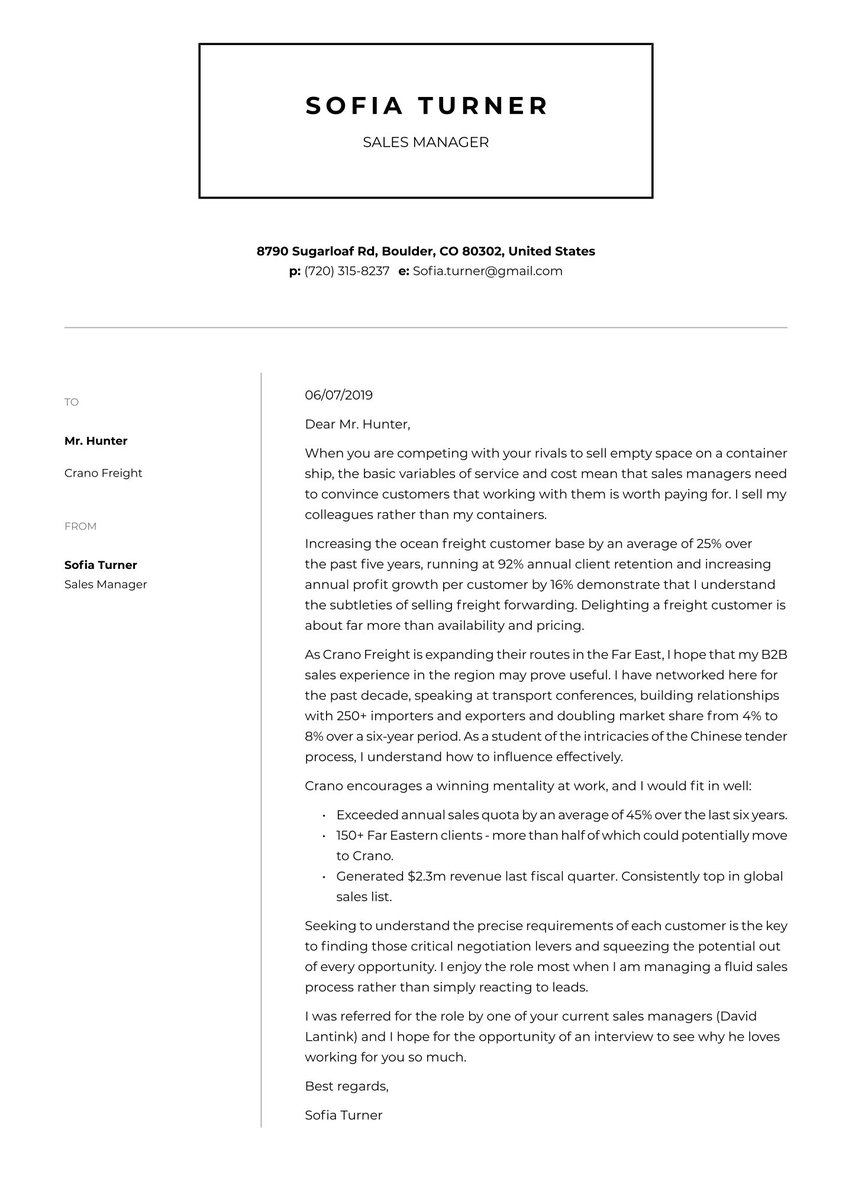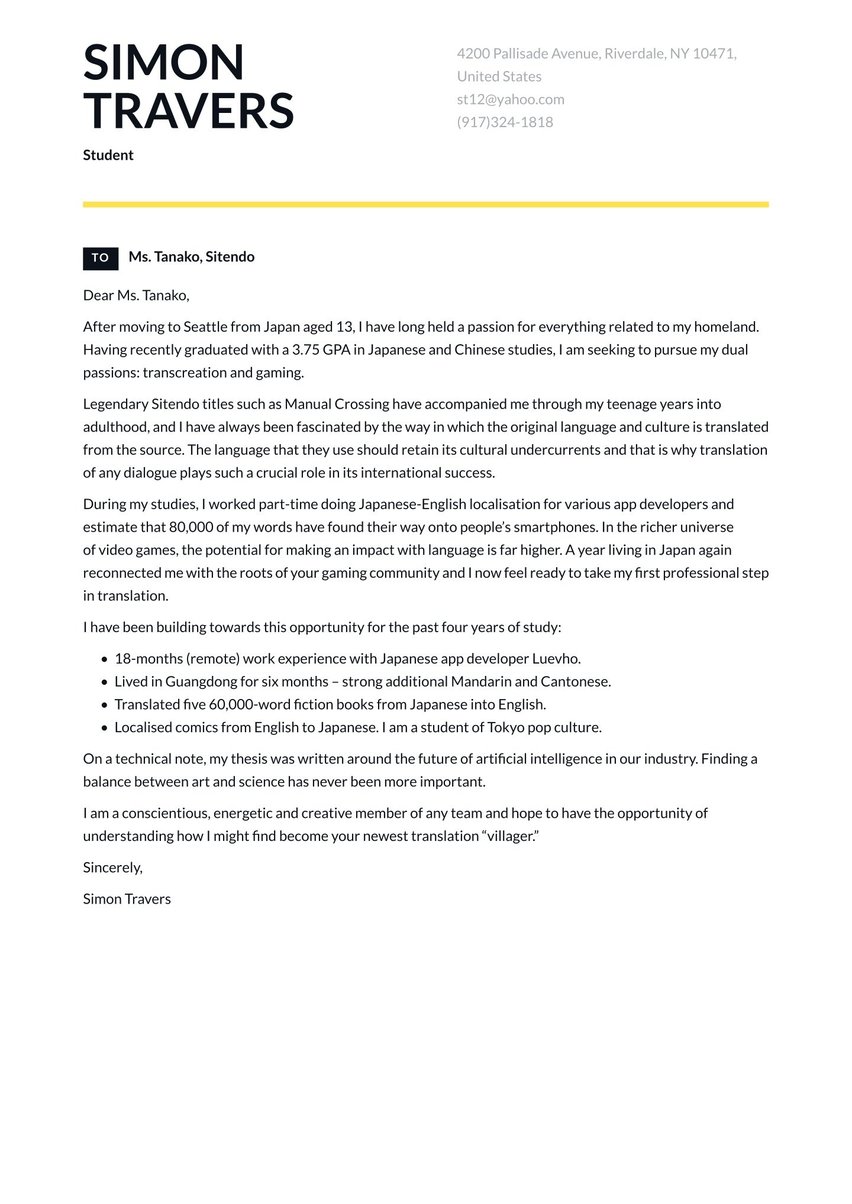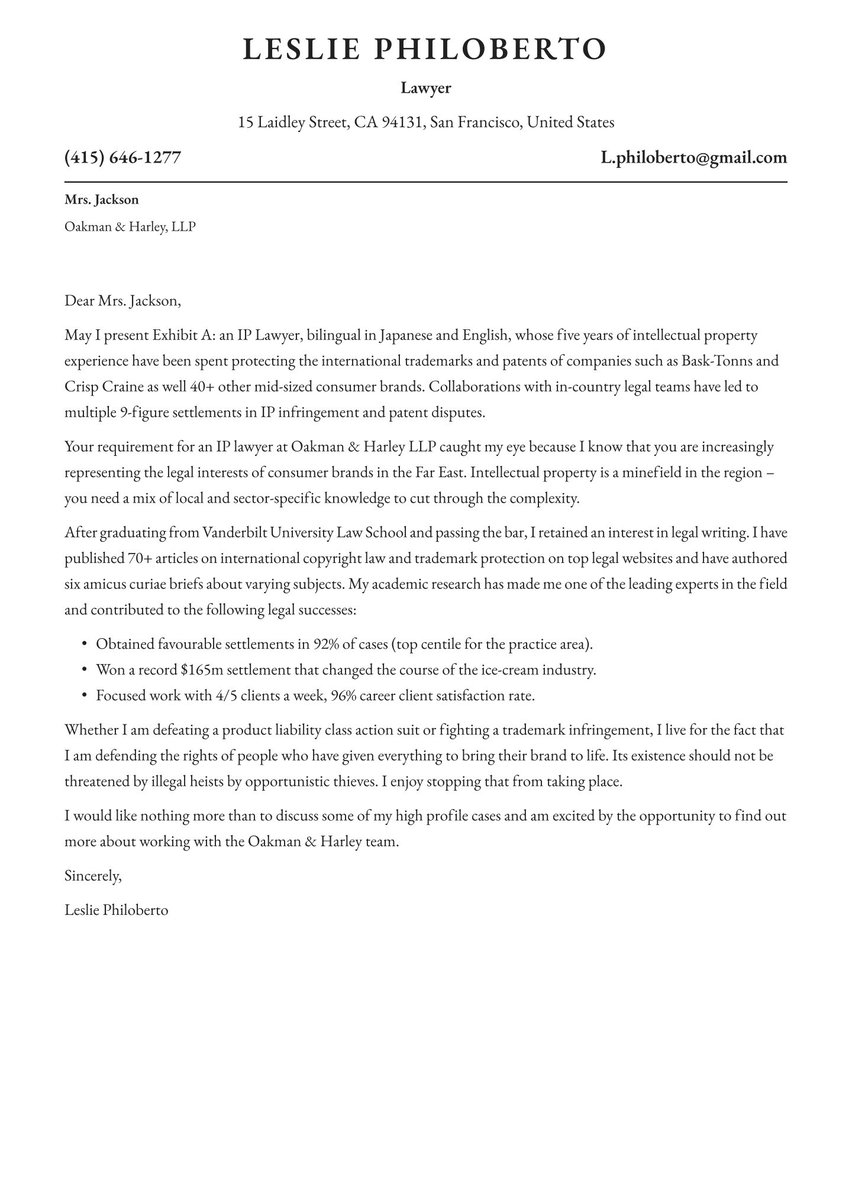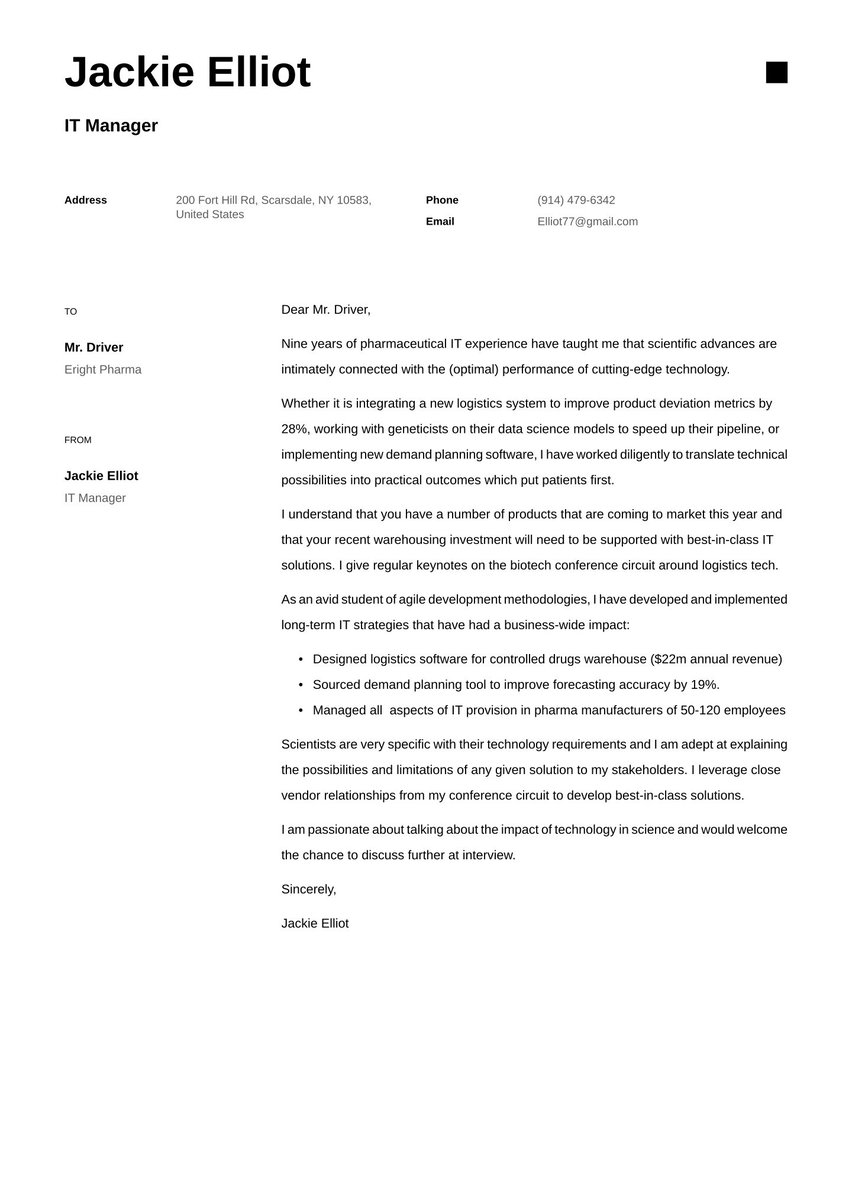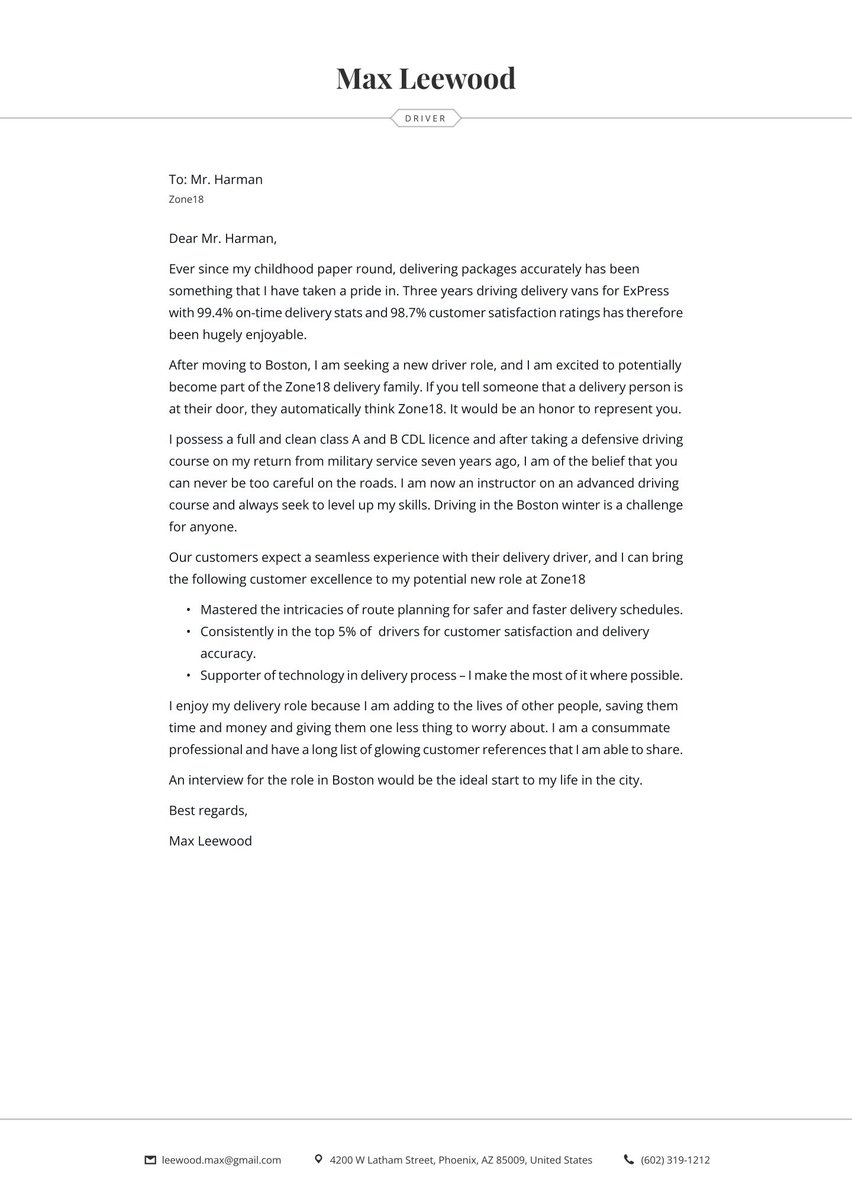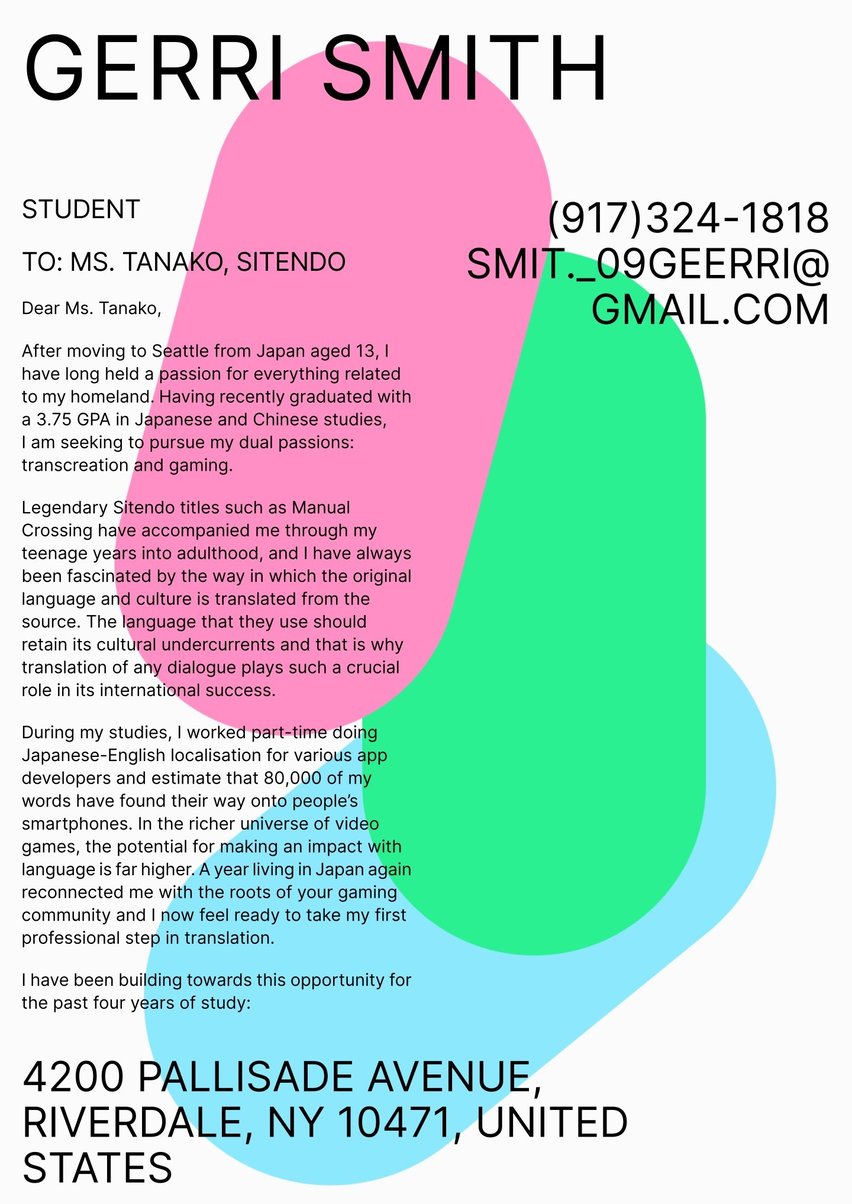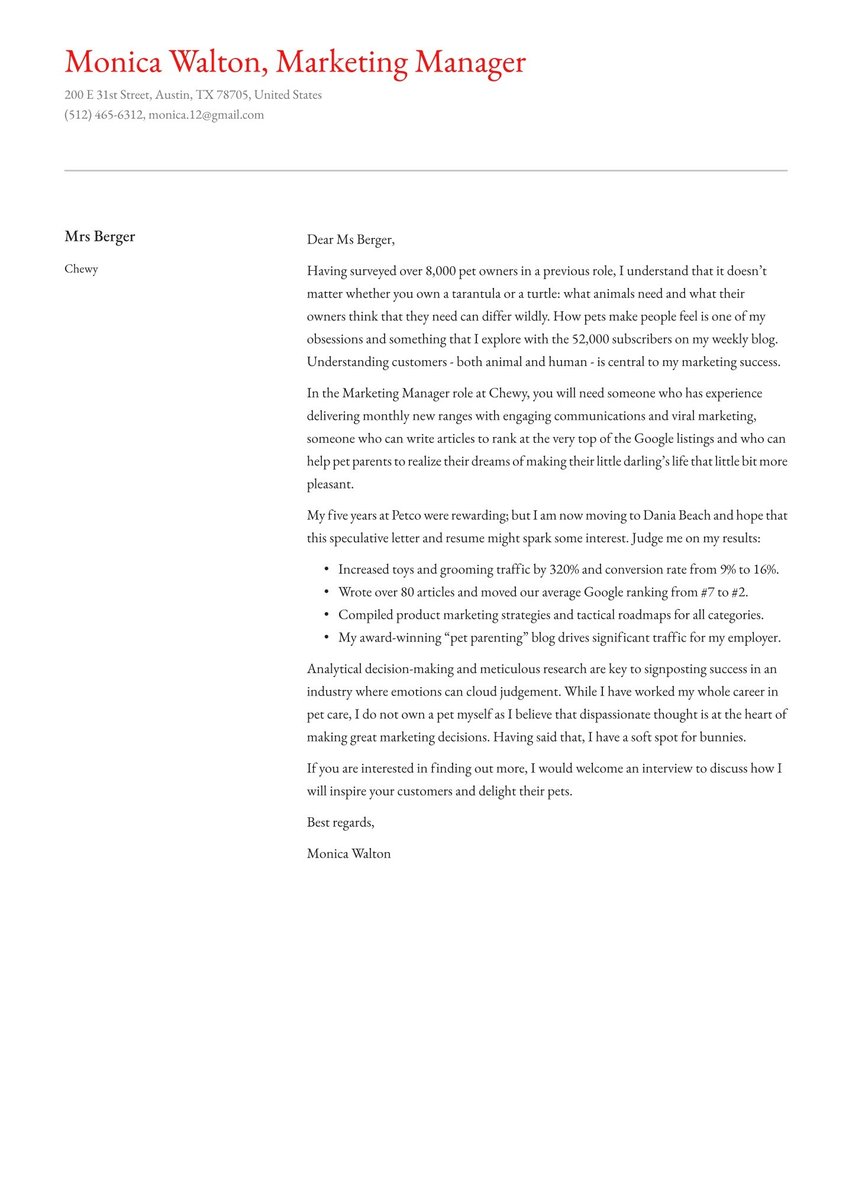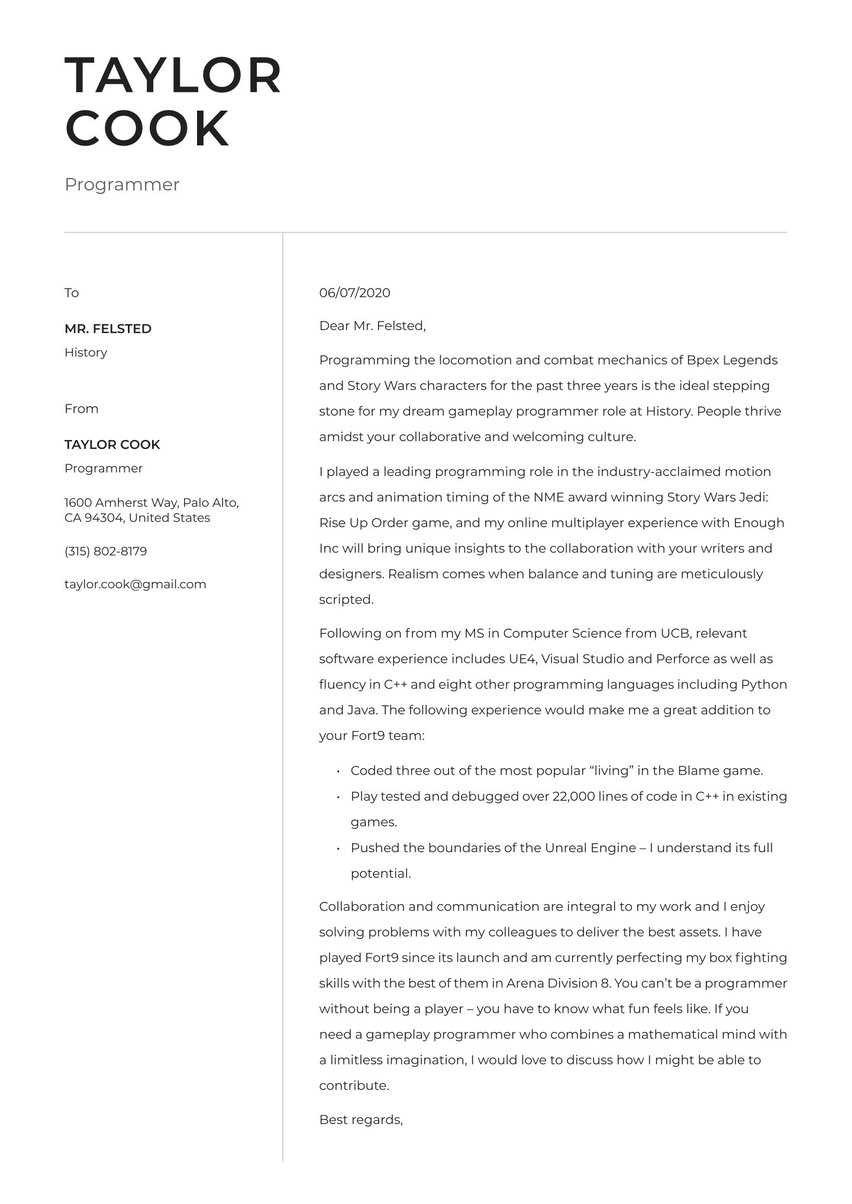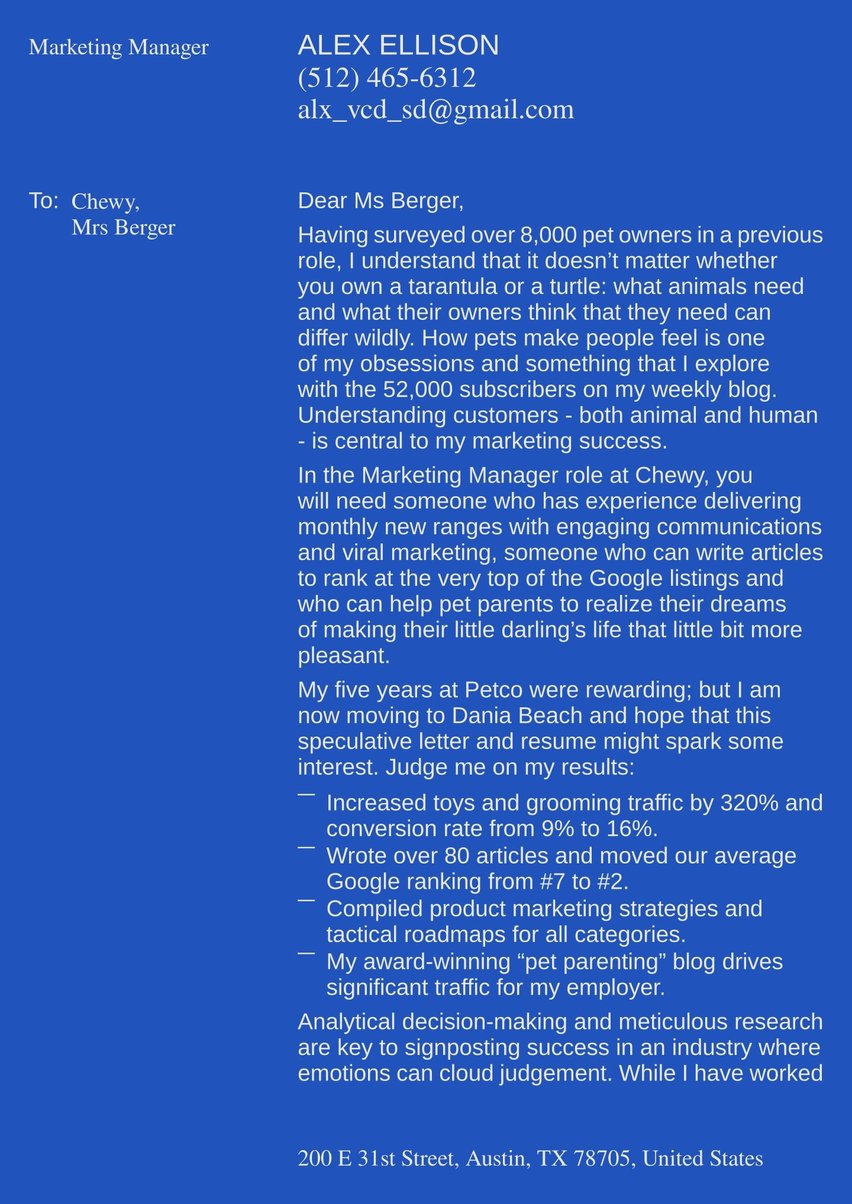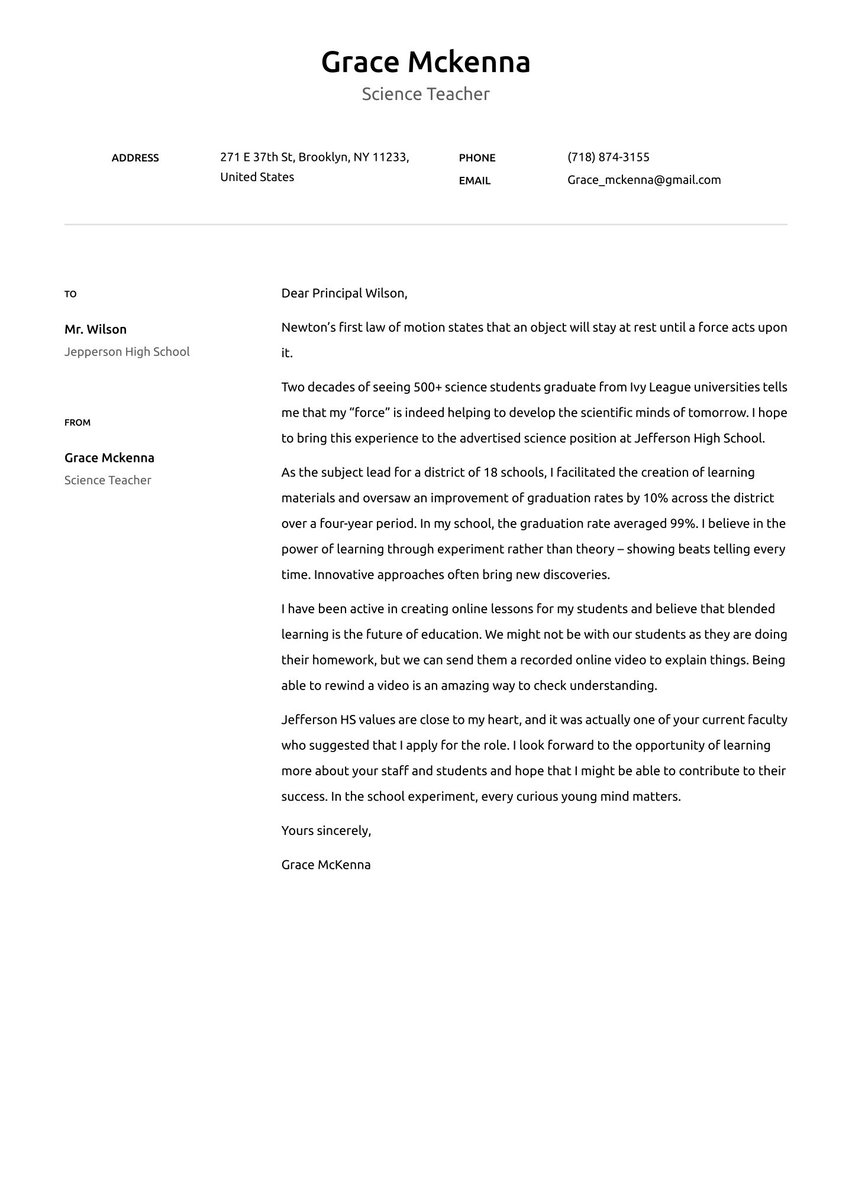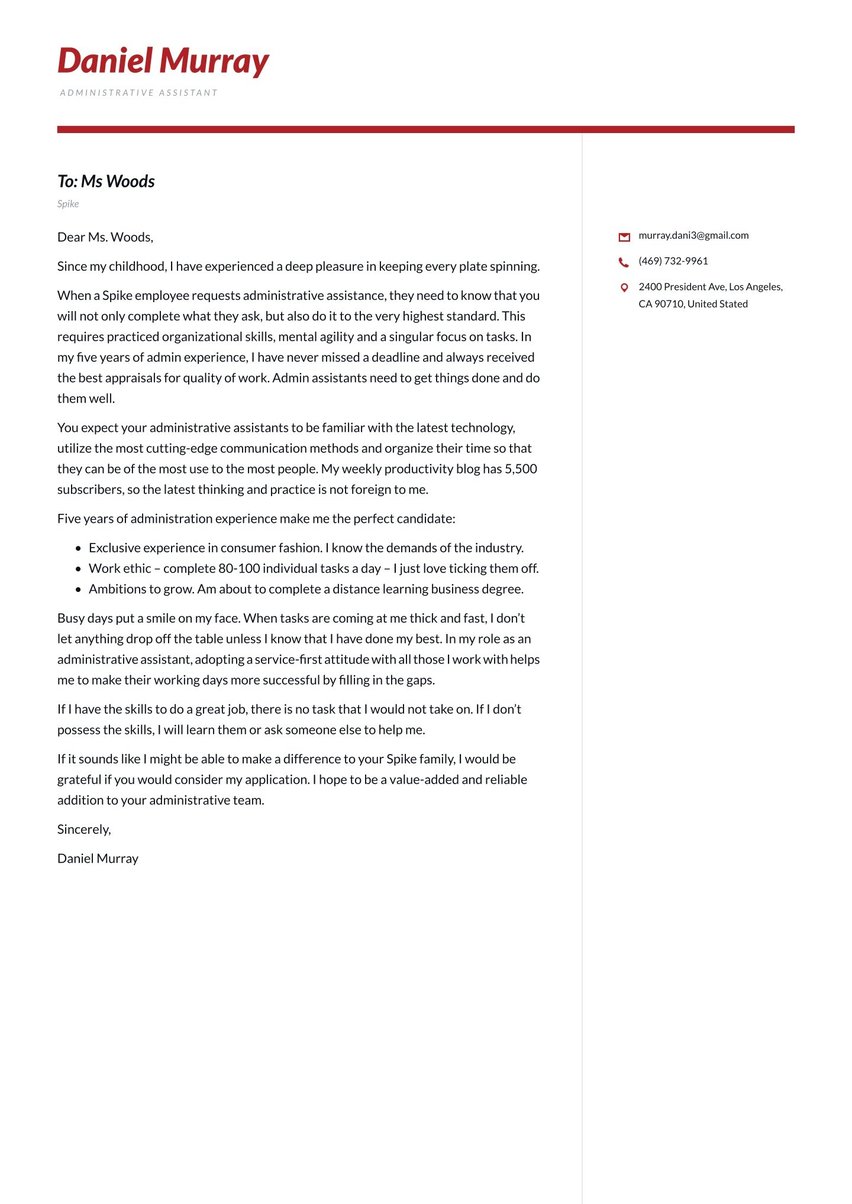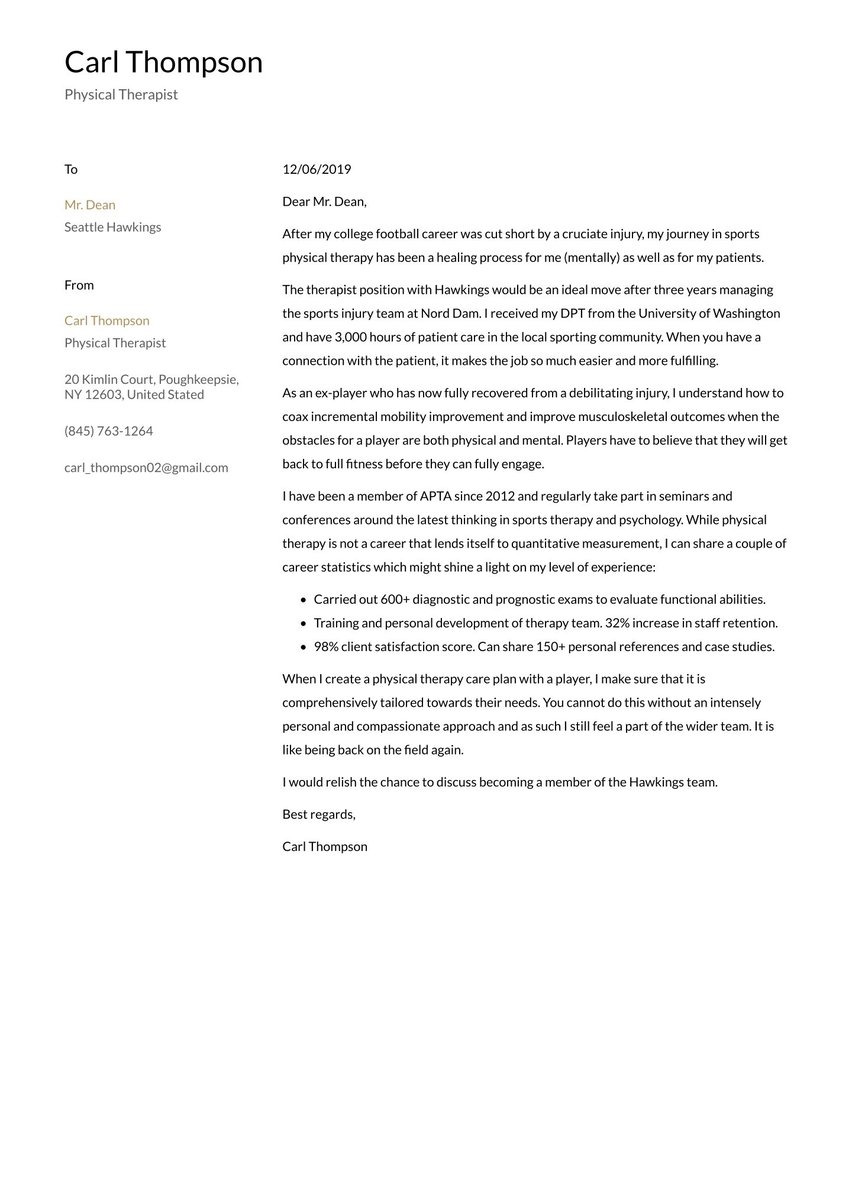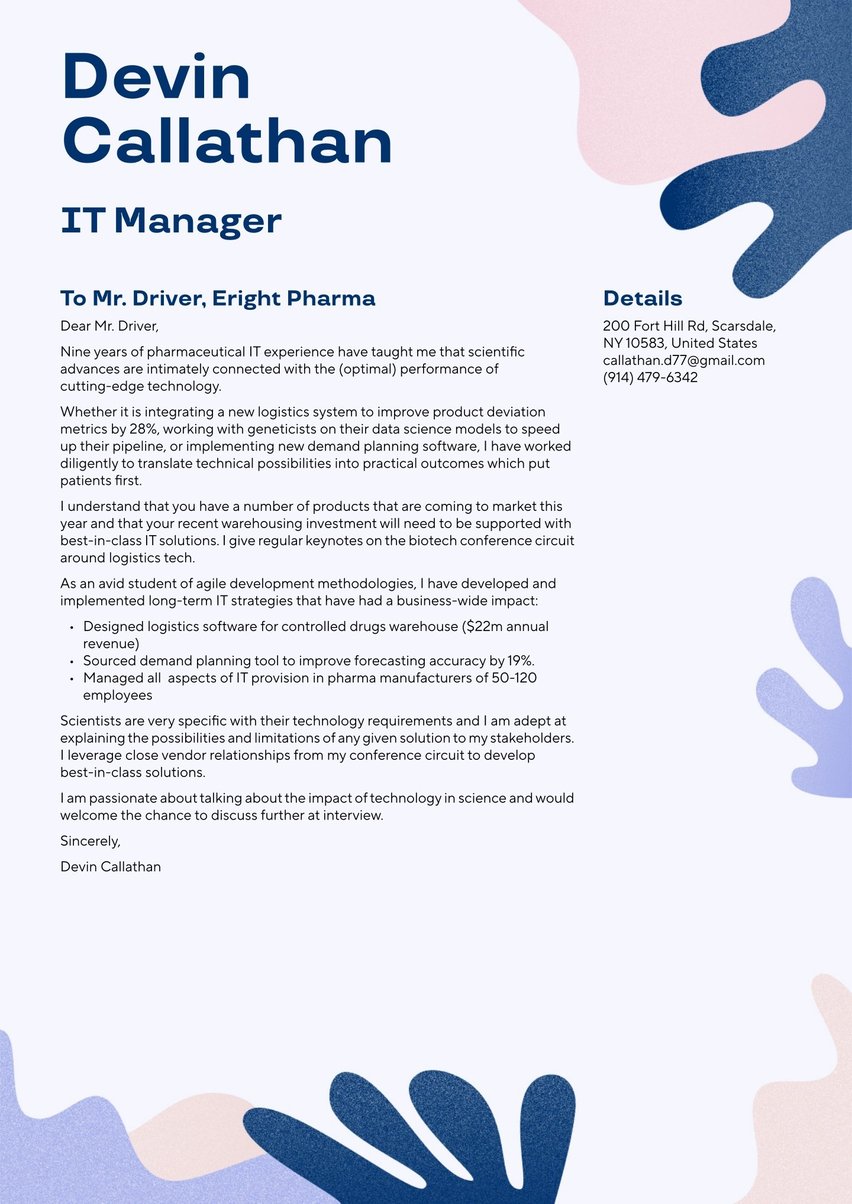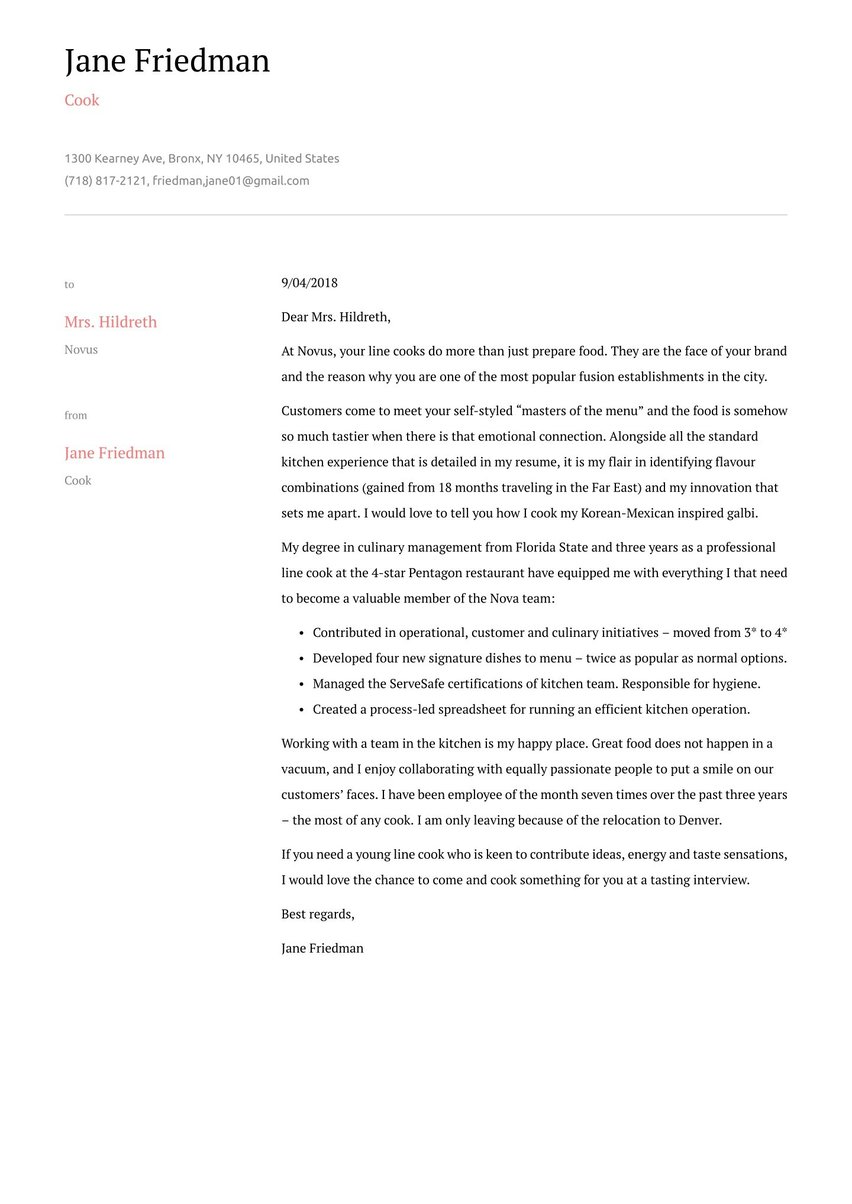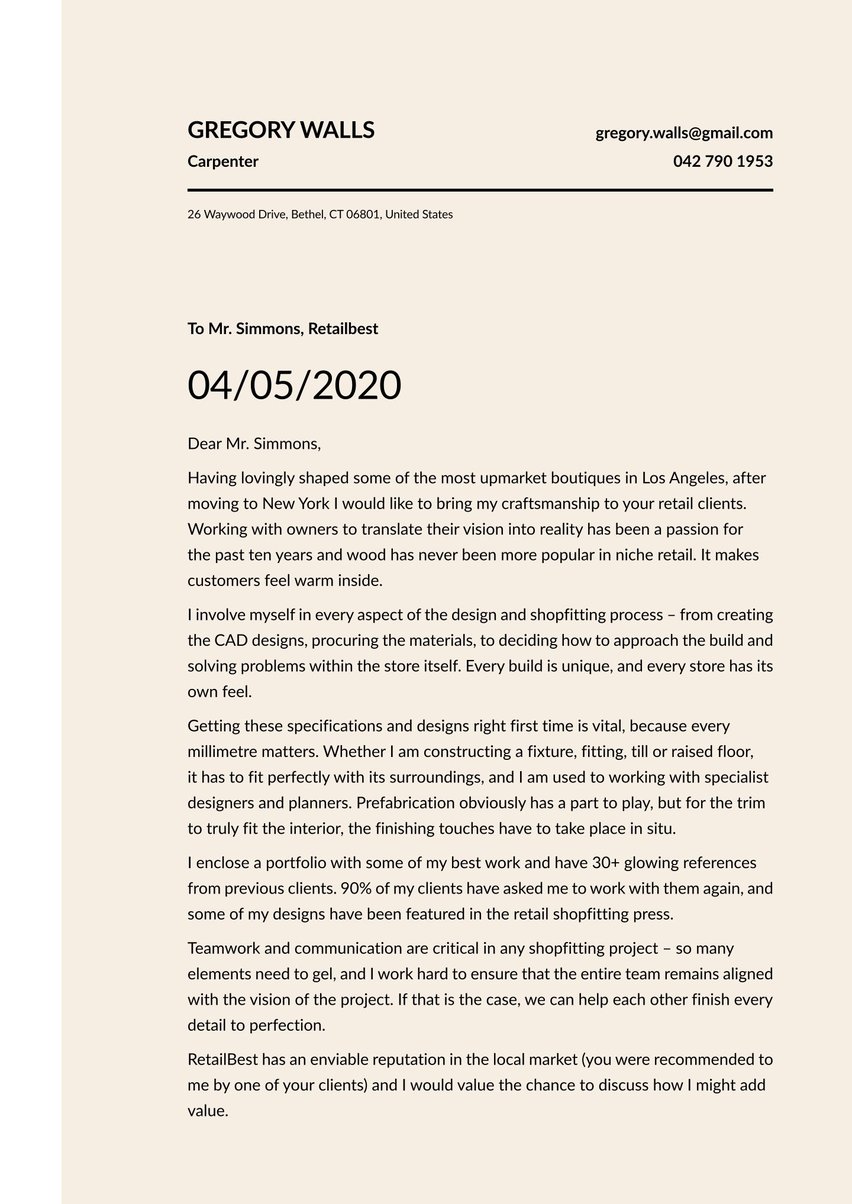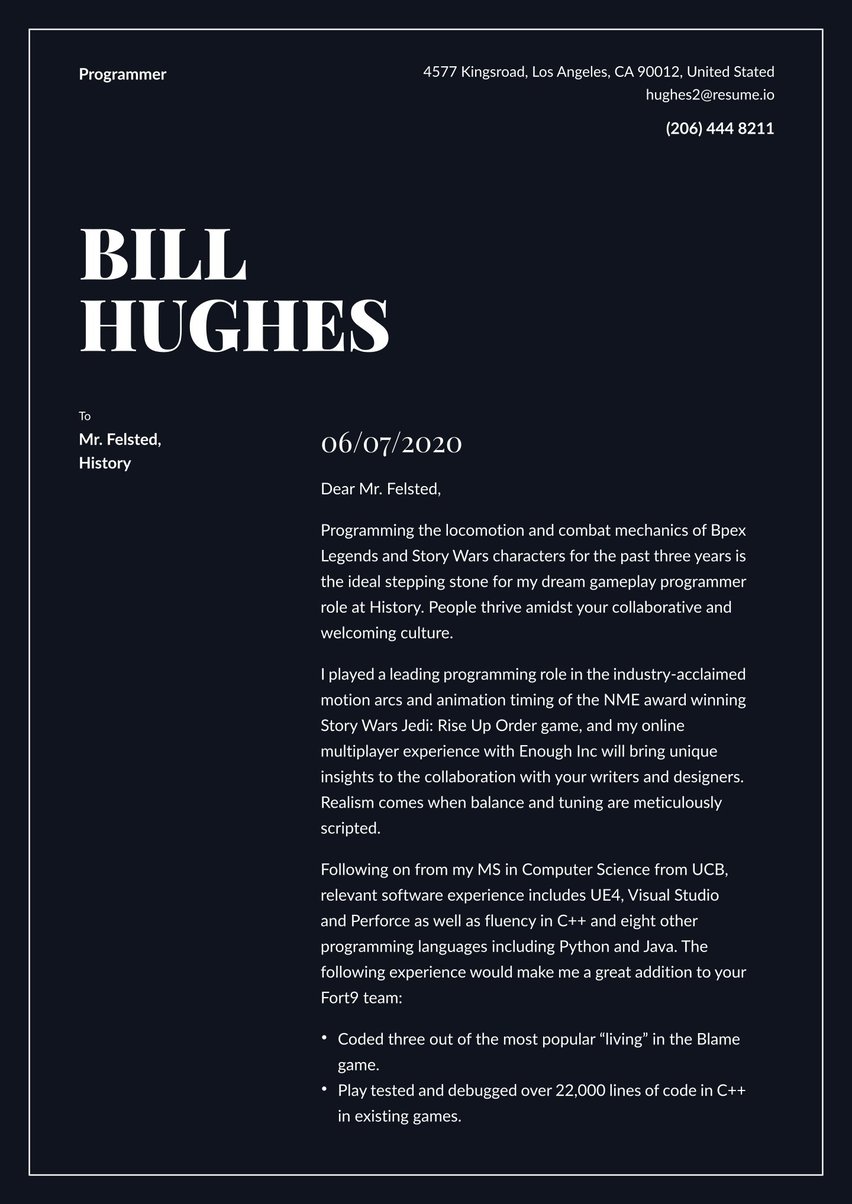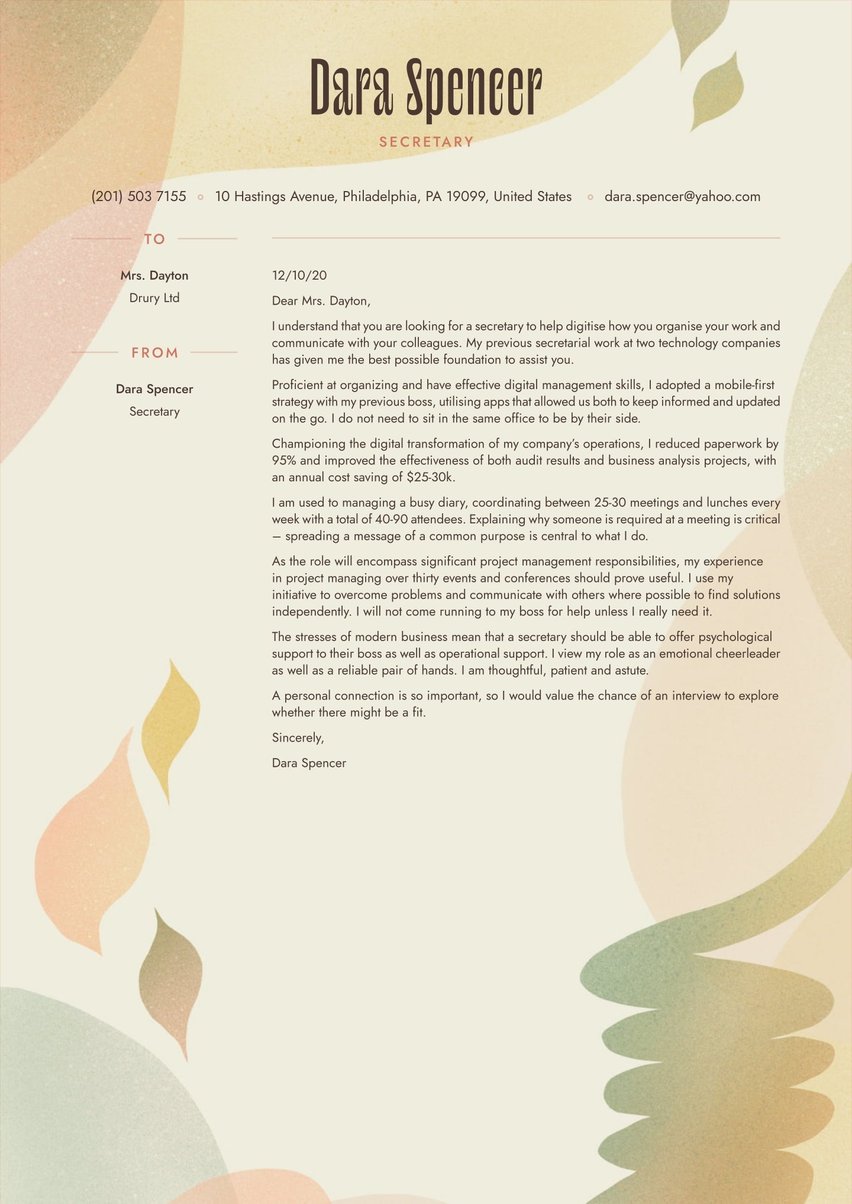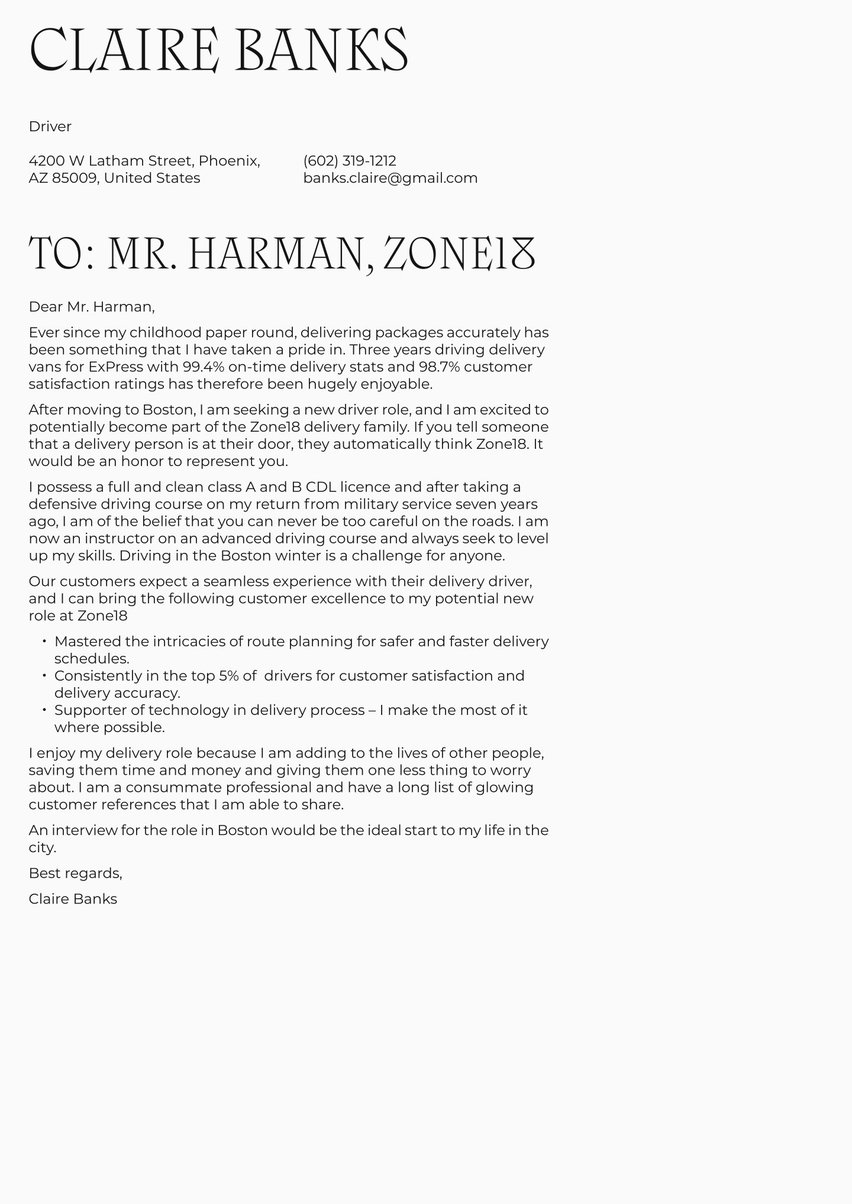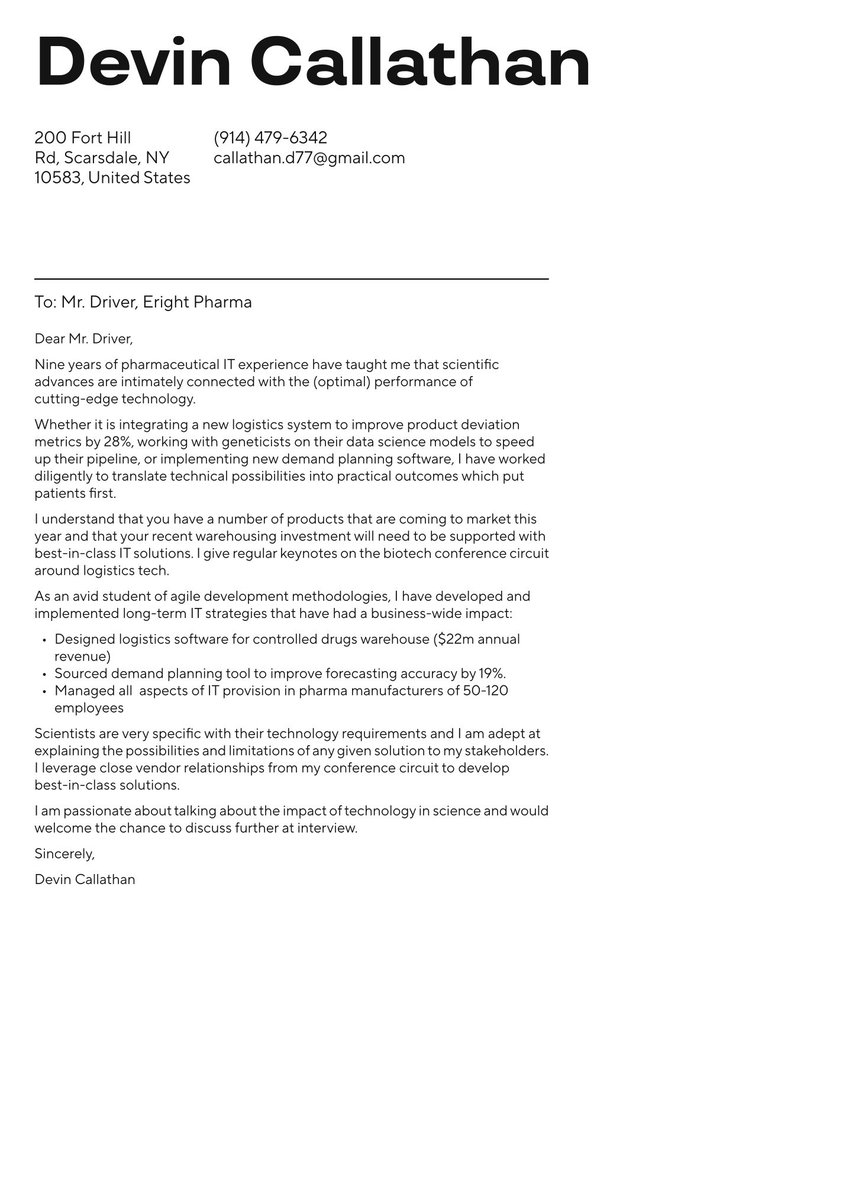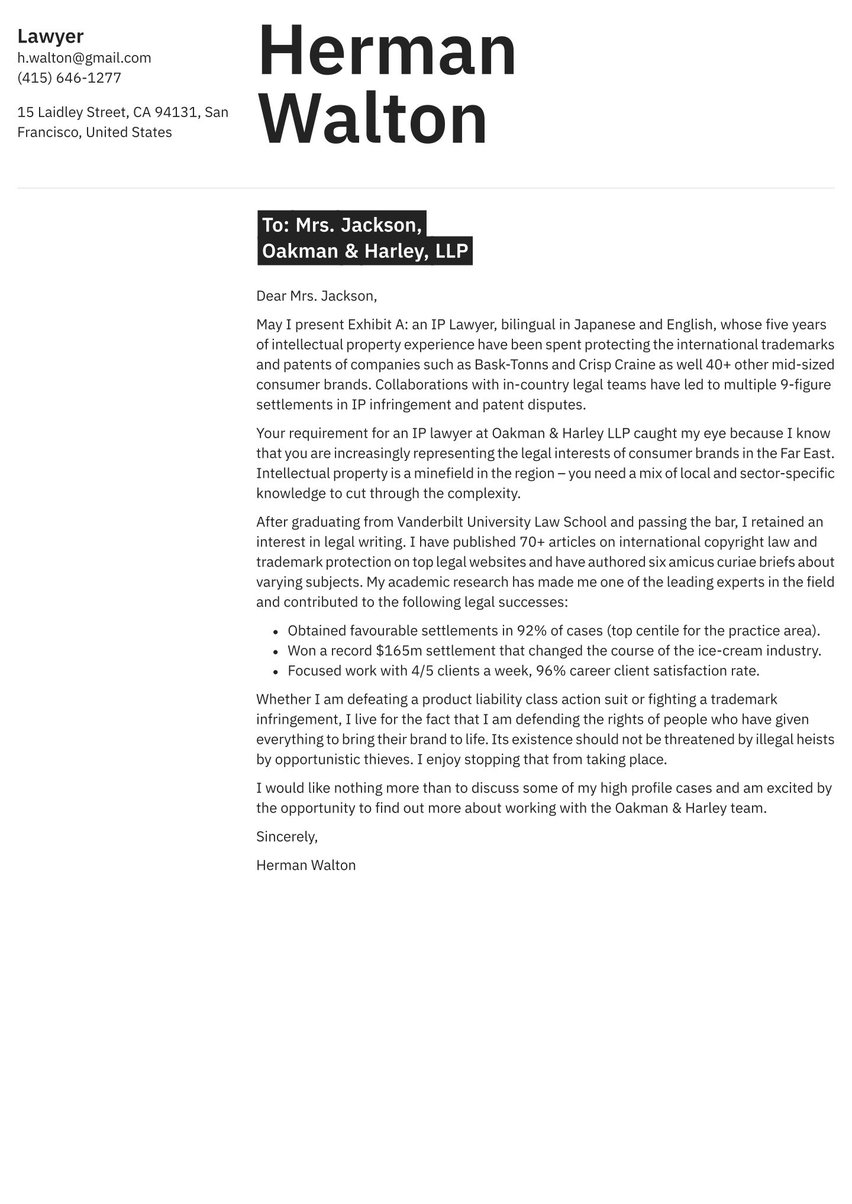Financial occupations involve helping others manage money. And while these experts may work with reams of documents to do their jobs, they need only two to get those jobs: a resume and a cover letter.
A dazzling finance cover letter is essential to make you stand out from a growing pool of job seekers in the finance industry.
Whether they work with big banks or private individuals, financial specialists manage investments, balance books, analyze budgets and in general advise clients on how to improve their financial situation.
Job outlook and median annual pay for selected financial occupations requiring only a bachelor’s degree:
| Occupation | Projected new job openings, 2021-2031 (% growth) | Median annual wage, 2021 |
| Accountants and auditors | 81,800 (6%) | $77,250 |
| Securities and financial services sales agents | 47,700 (10%) | $62,910 |
| Loan officers | 12,600 (4%) | $63,380 |
| Financial analysts | 31,900 (9%) | $95,570 |
| Personal financial advisors | 50,900 (15%) | $94,170 |
| Source: U.S. Bureau of Labor Statistics | ||
Resume.io is a leading provider of resume and cover letter templates, as well as occupation-specific guidance on how to prepare them. Browse through our collection of cover letter examples and writing guides to get a better idea.
In this finance cover letter guide, along with the corresponding finance cover letter examples, we’ll cover:
- Why you should (almost) always include a cover letter when applying for a job
- The purpose and goal of a cover letter
- The structure and components of a cover letter
- Maximizing the impact of each section: header, greeting, intro, body and conclusion
- How to design and format your cover letter
- Psychology, tips and tactics for writing a persuasive letter
- Mistakes to avoid.
Let’s dive in.
Why you need a cover letter
Your resume should cover most of the bases needed for an employer to determine whether you’re qualified for a job, including your employment history, education and job-related skills. Yet a resume is a somewhat dry and impersonal document. It doesn’t even contain the words “I” or “you,” and it isn’t addressed to anyone.
A cover letter, on the other hand, is the equivalent of a personal introduction, a friendly greeting, a handshake. You ARE asking for a job, after all, and a cover letter is your way of asking nicely. A cover letter enables you to establish a personal connection to a hiring manager. And it enables you to showcase your personality, enthusiasm and passion in a way that a resume alone can’t.
One survey of hiring managers found that the failure to include a cover letter is among the top seven reasons resumes are rejected.
There are a few companies that prefer to receive a resume only without a cover letter, and of course you shouldn’t send employers something they don’t want. But unless you’re specifically asked not, you should always include a cover letter with a job application. If you don’t, the employer may rightfully wonder why you didn’t. Is it because you can’t write? Are you afraid your letter would do more harm than good? Are you too lazy to bother writing a one-page letter? Or do you feel so entitled to the job that you think your resume speaks for itself?
Obviously, you don’t want employers to be asking ANY of these questions. A well-written cover letter can only increase your chances of getting the job. But a failure to include one could be your undoing.
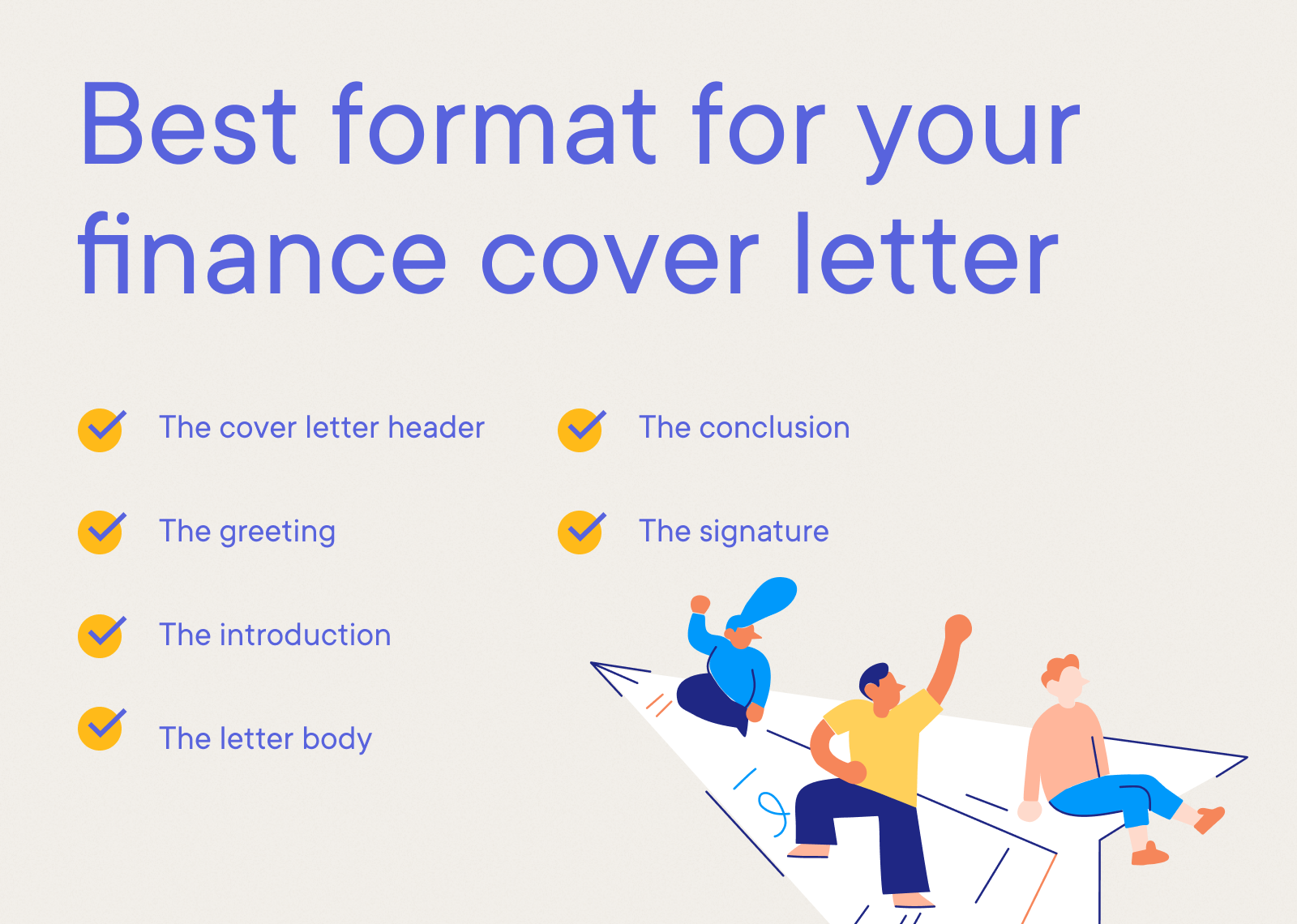
Best format to structure your finance cover letter
In most cases, a cover letter should be one page only, and a maximum of 400 words. Here are the components of a proper cover letter:
- The cover letter header
- The greeting
- The introduction
- The letter body
- The conclusion and signature
Understand the purpose of each of these, supply the proper information, and you’ll have a professionally structured finance cover letter that will get results.
Dear Ms. Sunderland,
Commercial finance in retail entails working with fluid forecasts, brave predictions and astronomical capex costings. Throughout my 14-year career, I have enjoyed a forecast accuracy of 96%, my product areas have beaten financial budgets by tens of millions, and the ROI on my capex outlay was consistently the best in the company.
Retailers need to spend money to earn money, but it is my job to ensure that the right money is spent on the right things. When everyone has a different opinion, being the gatekeeper to these sorts of decisions is far from easy. Having prepared 250+ financial plans and signed off over 120 capex proposals, I have seen (and made) plenty of mistakes, but a healthy profit margin simply means keeping that margin of error lower than competitors.
As an expert in the homewares business, I understand the financial requirements of running a first-class product sourcing operation. I have dealt with retail procurement for more than a decade and have negotiated with vendors and transport providers from around the globe. Cash flow management is critical when the products have longer lead times – in my last role I negotiated down debtor days from 78 to 62 and redesigned how we purchased and stored spot buy promotions to save over $3.6m.
Understanding your strategic direction, these further achievements may be of interest:
- Working in a commercial finance team of 8 – led the buyer liaison committee.
- Analyzed and costed over 90+ range reviews and led forecasting for 18 seasons.
- Led product cost saving initiatives to deliver a yearly cost reduction averaging 2%.
Unlike other finance roles, when you work in retail, you must have an eye for the product as well as the numbers. I am passionate about the sector and am not afraid to challenge decisions and guide strategy. I am as good with cushion-ranging as I am with spreadsheets.
I would welcome the opportunity of an interview to understand the scope of the role.
Sincerely,
Simon Root
For more specific samples with cover letter writing hacks from industry insiders, see one of our dedicated guides:
- Accounting cover letter sample
- Banking cover letter sample
- Administration cover letter sample
- Bookkeeper cover letter sample
- Finance Assistant cover letter sample
- Finance Manager cover letter sample
- Bank Teller cover letter sample
- Auditor cover letter sample
- Private Equity cover letter sample
- Accounting and finance cover letter sample
- Bank Manager cover letter sample
- Loan Processor cover letter sample
- Accounting Internship cover letter sample
- Financial Advisor cover letter sample
- CFO cover letter sample
Cover letter header
The top of your finance cover letter should contain an attractively designed header that contains your name, address, phone number and email. Often it may briefly identify your occupation also (like “Financial Analyst”). Snail mail addresses are considered less important now than they used to be, but you should usually include one unless there’s a good reason not to.
The first reason for the header is obvious: You want the employer to know how to reach you. But it also has a design function in that it allows you some room for creativity, incorporating white space and perhaps a splash of color. Below the header, your letter will contain nothing but body text, but the header gives you a way to make your letter more visually attractive.
Align document styles
Your resume and cover letter should be a “matching set,” so give them a matching style. That means use the same fonts, font sizes and formatting styles for both.
Applying the same look and feel to these two documents gives you a “visual brand,” and it shows you pay attention to detail. It should be obvious at a glance that both of these documents came from the same person. One risk of using different styles for your resume and cover letter is that it may appear you’re using an old, generic resume done in a style that you haven’t bothered to update lately. The two of them should be prepared as a package intended for the same set of eyes, and they should have a cohesive design.
Aim of the cover letter header: Identify yourself, with contact information, in a distinctive manner that stands out from other job applicants. Also create a visual brand identity consistent with your resume style, showing regard for detail.
Cover letter greeting
“Dear Mr. (Last Name Here):” is the time-honored style of writing a salutation in a business letter, and you can’t go wrong with this simple, traditional approach in your finance cover letter. (Of course, you would substitute “Ms.” if the recipient is a woman, or “Dr.” if appropriate.)
In traditional business letters, the greeting ends with a colon, though the age of email has made commas acceptable too. Some even consider “Dear” a bit archaic, preferring a more informal “Greetings” or “Hello.” But beware of being too informal in a letter written to someone who has the power to offer you a job. And avoid addressing this person on a first-name basis unless you already know each other.
It’s almost always best to address your letter to a specific person. It shows your attention to detail and your seriousness about this job if you’ve gone to the trouble of finding out who’s doing the hiring. (But spell the name wrong, and you’re toast!)
People like to read their own names. And they are more inclined to answer a letter that’s addressed to them rather than to an entire company or department. Job listings often don’t name the person to whom you should submit your application. If that’s the case, consider calling the company to inquire. However, if you get the sense that the hiring manager doesn’t really want to be identified by name, then find a way to write a more generic greeting, like “Dear (Company) Hiring Team.”
Aim of letter greeting / salutation: Start off on a professional note by addressing the hiring manager by name if possible, in as formal a manner as appropriate for the employer.
Cover letter introduction
Many writers will tell you that the first paragraph in any story is the most important. That’s because the first paragraph is where the reader decides whether to keep reading. It’s also true for an effective finance cover letter. You need to get off to a great start.
In writing your cover letter introduction, remember that you are literally introducing yourself to someone you don’t know. You don’t need to say, “Hello, my name is …” but you do need to strike a friendly tone and provide some information about who you are and why you’re writing. The introduction should both mention your job objective and offer a brief preview of your qualifications. It should use lively, energetic, cliché-free language that makes you sound like a positive, confident, qualified professional.
Above all, your introduction should make the reader want to read on.
Aim of the cover letter introduction: Capture the hiring manager’s attention with a compelling preview of your qualifications to motivate reading more.
Dear Ms. Sunderland,
Commercial finance in retail entails working with fluid forecasts, brave predictions and astronomical capex costings. Throughout my 14-year career, I have enjoyed a forecast accuracy of 96%, my product areas have beaten financial budgets by tens of millions, and the ROI on my capex outlay was consistently the best in the company.
Cover letter body
This is where you must deliver the goods. In the central two or three paragraphs of your cover letter, you need to demonstrate that you are eminently qualified for the job. Employers value experience above all, so this is the place to showcase that you are a proven success in your field. You need to mention not just your previous jobs, but what specifically you accomplished at those jobs.
Think of the symbols #, $, and %, and use facts and figures wherever possible: numbers, dollar figures, percentages. People love a good story, so tell one. Relate an anecdote about a daunting challenge you once faced on the job and what action you took to resolve it to everyone’s satisfaction.
If your experience in the field is limited, perhaps because you’re just graduating from college, emphasize your academic achievements, your professional potential and your ambitions for the future. But whatever your situation, you need to identify the top qualifications that make you right for the job, and you need to describe these in the body of your letter.
Aim of the cover letter body: Highlight your most relevant accomplishments in a relatable way, so the employer can envision your potential contributions if hired.
Retailers need to spend money to earn money, but it is my job to ensure that the right money is spent on the right things. When everyone has a different opinion, being the gatekeeper to these sorts of decisions is far from easy. Having prepared 250+ financial plans and signed off over 120 capex proposals, I have seen (and made) plenty of mistakes, but a healthy profit margin simply means keeping that margin of error lower than competitors.
As an expert in the homewares business, I understand the financial requirements of running a first-class product sourcing operation. I have dealt with retail procurement for more than a decade and have negotiated with vendors and transport providers from around the globe. Cash flow management is critical when the products have longer lead times – in my last role I negotiated down debtor days from 78 to 62 and redesigned how we purchased and stored spot buy promotions to save over $3.6m.
Understanding your strategic direction, these further achievements may be of interest:
- Working in a commercial finance team of 8 – led the buyer liaison committee.
- Analyzed and costed over 90+ range reviews and led forecasting for 18 seasons.
- Led product cost saving initiatives to deliver a yearly cost reduction averaging 2%.
Unlike other finance roles, when you work in retail, you must have an eye for the product as well as the numbers. I am passionate about the sector and am not afraid to challenge decisions and guide strategy. I am as good with cushion-ranging as I am with spreadsheets.
Cover letter conclusion and signature
Your last paragraph should be both a wrap-up and a call to action. The last thing you want is for your correspondent to set your letter aside and never do anything about it.
You might ask whether you could call next week to see about scheduling an interview. You might mention that you are always reachable at the phone number and email address you’ve provided. At the very least, you should make it clear that you are eager to hear back. Plant the idea in your reader’s head that you are not just writing to shoot the breeze — you would actually like a response!
Your letter should end with a “Sincerely” or a similar close, followed by a space and your typed name. Unless you’re sending a hard copy, an actual signature is not required, though it does no harm to insert a digital version of your actual signature.
The aim of the conclusion: Finish on a confident note with a call to action that ideally results in an interview.
I would welcome the opportunity of an interview to understand the scope of the role.
Sincerely,
Simon Root
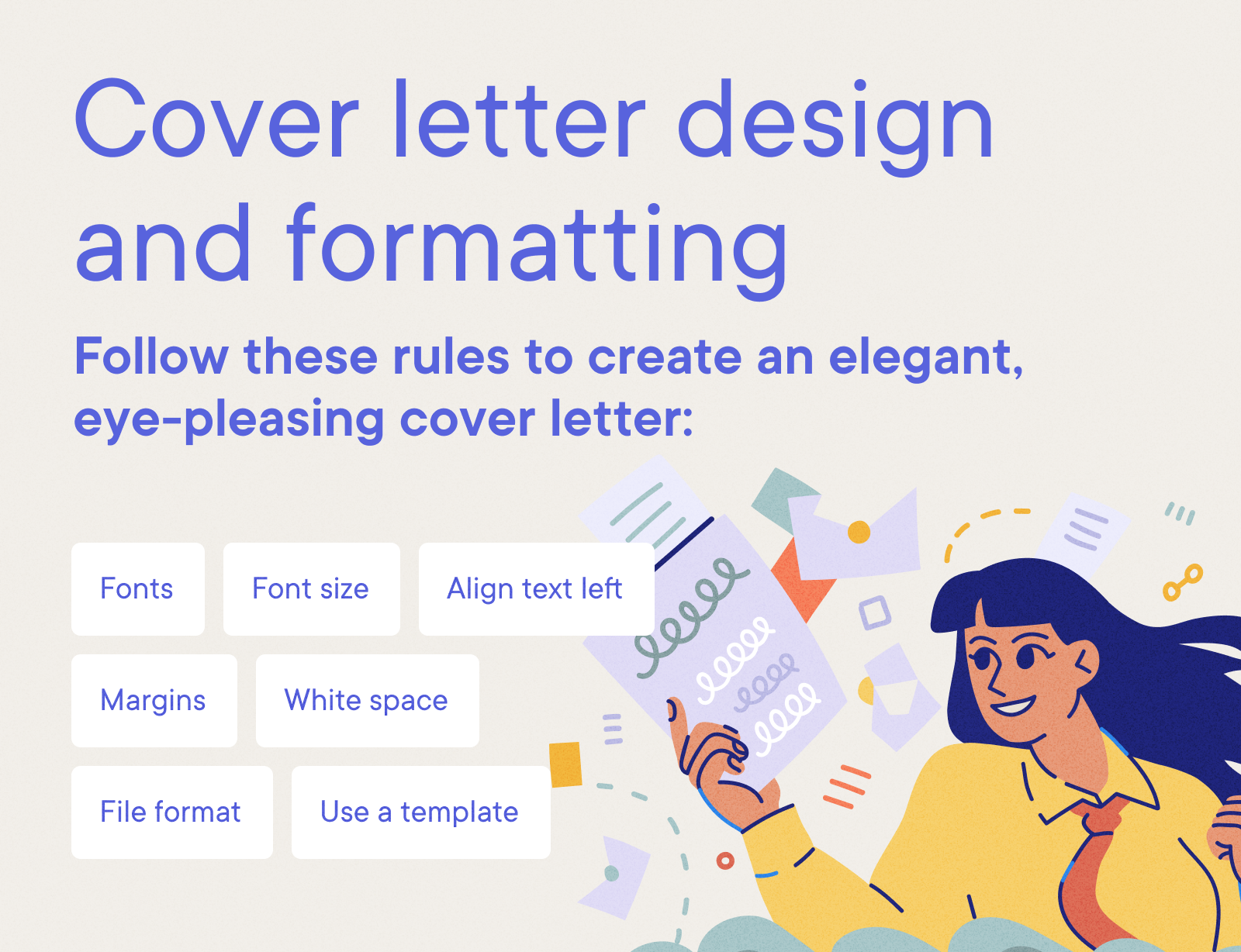
Cover letter design and formatting
It would be a mistake to pour all your energy into what your letter says, but to devote no thought to how it looks. In fact, bad design and formatting can be a deal-killer just as surely as lazy writing full of typos.
Follow these rules to create an elegant, eye-pleasing cover letter:
- Fonts: Use an attractive, easy-to-read, professional-looking font. Avoid fonts that are unusual or flashy.
- Font size: Your body text should be 10 to 12 points. Too small and it’s hard to read; too big and it looks childish. If your letter doesn’t fit on one page, trim the fat before you try reducing the font size.
- Align text left: Body text that’s aligned left, or “ragged right,” leaves a space at the end of each line where the last word ends (like the text you’re reading now). This white space gives the eye a break and creates a more pleasing look for the entire page. Text that is justified from margin to margin works fine in books, but in a one-page letter it creates a blocky look, and sometimes it awkwardly stretches words out horizontally.
- Margins: Left, right, bottom and top margins should all be one inch.
- White space: Leave room on the page for space that contains nothing at all. Any graphic designer will tell you that white space is essential to good design because it gives the eye and brain a break from sensory overload.
- File format: Save your letter as a PDF unless you’re specifically asked to send it in some other format. PDFs preserve the formatting of the original document, while other file types can make your text jump around or turn to garble when opened on another computer.
- Use a template. Resume.io offers professionally designed cover letter templates that have already incorporated all these rules of design and formatting. Download a professional template, fill in your own information correctly, and you’ll have a flawless cover letter.
Psychology, tactics and tips
Once you’ve written a draft of your cover letter, put yourself in the seat of the person you want to send it to. If you were the hiring manager and you received this letter, would you want to meet the person who wrote it? Would you be open to the idea of working with this person for years to come? There’s an art and a science to persuasive letter writing, and it starts with getting inside the head of your correspondent.
One way to look at it: Don’t write the letter you want to write. Write the letter you want your correspondent to receive. Do not try to convince your correspondents that you need a job. Convince them that they need you. You may be able to increase productivity, cut redundancy, improve efficiency or in some other way improve the company’s bottom line. Make your cover letter about the company’s needs, not yours.
This job might make you richer, but your emphasis should be on how your contribution would enrich the company.
What not to do
Here are some common mistakes to avoid in writing a cover letter:
- Typos, misspellings and bad grammar: Sloppy writing mistakes, whether in the resume or cover letter, are said to be the most common reason job applications are rejected.
- Clichés and corporate jargon: If you consider yourself a “team player” and a “self-starter,” keep it to yourself. There are certain hackneyed phrases that have become so overused in resumes and cover letters that they’ve become a total detriment. Write in fresh, original language, and write like a human being, not a corporate robot.
- Copy-and-paste letters: Sending the same cover letter to 50 employers is a sure way to end up with zero jobs. Make each letter original, addressing the needs of a specific employer.
- TMI: Hobbies and life achievements that have nothing to do with the job you’re seeking are too much information to include in a cover letter.
- Bad formatting: From bad fonts and tiny text to strange file types, errors in design and formatting can quickly sink your ship.
The surest way to sidestep any potential errors in formatting and design is to use a professional template from resume.io. Our field-tested cover letter templates and builder tool make it easy to create letters that will work. We can’t write the letter for you, but we’ll give you a proven structure to build on.
Key takeaways for a finance cover letter
- While a resume is an impersonal listing of your job qualifications, a cover letter is your personal introduction to a hiring manager. It enables you to showcase your personality, enthusiasm and likability.
- Follow the guidelines for a properly structured cover letter. From your header to your sign-off, understand the purpose of each component and write your letter accordingly.
- Remember that you’re not writing to convince anyone that you deserve a job — you’re writing to convince an employer that it needs you.
- Your letter should look as good as it reads — so pay attention to fonts, font sizes, margins and a judicious use of white space.


